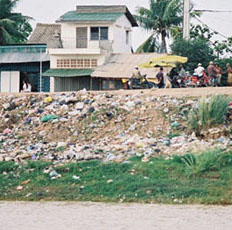Seasonal and
Spatial Variations in Water Chemistry--
Flow and water chemistry are the primary factors governing life in riverine
habitats, and both are closely related to seasonal variations. Different
scales of variation have different effects on where the biota live and
which biota are present. These differing scales are presented in the following
table.
|
Scale
|
Space
|
Time
|
| Small | Within-stream reach: influences flow, substrate, particle size, organic matter retention and vegetation | Daily/short-term variation: temperature and oxygen; flow related to current, shear stress and substrate; chemical changes related to pulses of increased velocity and sediment and reduced pH; flood disturbance |
| Medium | Longitudinal distance within river: longitudinal change in temperature, oxygen, water chemistry, flow and flow variability, substrate and energy inputs | Seasonal changes: temperature and climate, water chemistry, discharge and current velocity, energy inputs, pollution and flood disturbances |
| Large | Differences between streams: water chemistry, particularly pH, related to geology and land use | Interannual: water chemistry and temperature related to changes in land use, directed chemical changes involving pollution, acidification and nutrient loading; climatic variation |
| Very large | Biogeographic patterns: catchment area; river length; history and chance, not related to habitat | Historical-evolutionary time: development of river and succession processes in the surrounding landscape; major climatic changes |
Human Impacts
- Pollution--
Pollution can be defined as the release of harmful materials, typically
generated through human activity (e.g., industry, domestic waste, agriculture)
into the receiving environment. At their most extreme, toxic discharges
can produce mass mortalities and prolonged contamination can reduce numbers
of aquatic organisms and biodiversity. Even where discharges do not have
obvious impacts, long-term (sub-lethal) effects caused by toxic compounds
such as pesticides and heavy metals can produce grave consequences for
fish, wildlife and humans dependent on the system. Pollution reaches the
aquatic system in two forms.
 |
• Point-source pollution
is discharged in the system through a single source such as a pipe
or outlet, usually from an industrial or sewage treatment plant. Most
toxic industrial and urban wastes arrive in a river or lake in this
way. As such effluents are relatively easy to control and trace, and
responsibility for any pollution incident is correspondingly easy
to assign and prove. • Diffuse-source pollution is mainly the result of agricultural and forestry activities, although it can also occur where there is small-scale mining over a large area. Pollutants are usually pesticides, herbicides, and agricultural antibiotics, which are transmitted to the aquatic system with seepage of rain and groundwater. This type of pollution is extremely difficult to isolate and control, as it is often a function of large-scale cultural practices over very wide areas. |
Persistent Organic Pollutants (POPs) are chemical
substances that persist in the environment, bio accumulate through the
food web, and pose a risk of causing adverse effects to human health and
environment.
Persistent
Organic Pollutants (POPs)--
POPS are either used as pesticides, consumed by industry, or generated
unintentionally as by-products of various industrial processes. The 12
POPs, called the "Dirty Dozen" that are recognized as requiring
the most urgent action are; Aldrin, Chlordan, DDT, Dieldrin, Dioxins,
Endrin, Furans Heptachlor, Hexachlorobenzene (HCB), Mirex Polychlorinated
Biphenyls (PCBs).